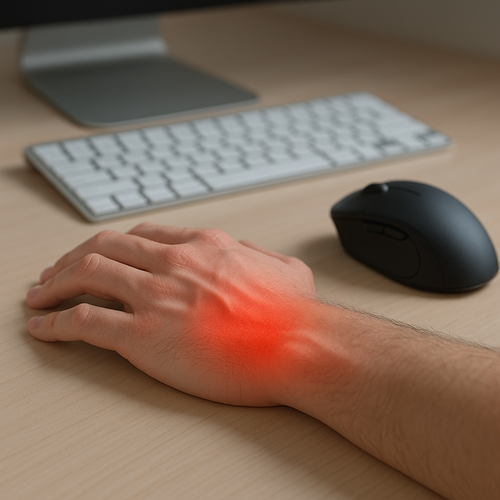If you are experiencing hand, wrist and forearm pain, you may want to try a wrist support for your computer keyboard and mouse.
However there are conflicting messages as to if wrists supports are beneficial or hinder pain while at the desk.
This article will guide you through what the wrist pain could be, why it happens, and how you can use a wrist support properly that could help increase comfort while at your desk.
What Causes Wrist Pain?

Wrist joint consisting of tendons and the median nerve surrounded by bone and ligament. This small tunnel is approximately 3cm in width.

What are Wrist Supports?

Example of a keyboard and mouse wrist support.
Wrist supports for your keyboard and mouse can have benefits to a computer worker, however they need to be placed and used correctly to see these benefits.
Julia Hillen
Occupational Therapist, No More Pain Ergonomics
Correct Positioning of a Wrist Support
When we think of a wrist support, we imagine that we place the support on the wrist joint itself, however this is the crucial mistake.
Position 1: Wrist Support on Palm of Hand
Place the wrist support so that the palm of the hand touches the support and leaves a gap between the wrist joint and the desk. See below image for example.

Example of how to position the wrist rest while typing on the computer.
Position 2: Wrist Support on Forearm
Place the wrist support away from the wrist joint up the forearm. This still provides rest for the hands while working on the computer and does not place any pressure on the Carpal Tunnel.
Important Consideration
If you have invested in a wrist support for a keyboard, ensure that you only use the tool sparingly.
The palms or forearms should not be rested on the wrist support for long periods of time. This may mean you will need to re-train your typing technique so that your wrists are hovering over the keyboard as opposed to resting on a support or the desk. The support should be for intermittent use while in between typing sessions.
Conclusion
















← Older Post Newer Post →
0 comments
Get in Touch
Still have a question or simply want to discuss what ergonomic products are best suited? Get in touch, our expert team is available to provide free advice and support.